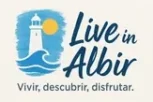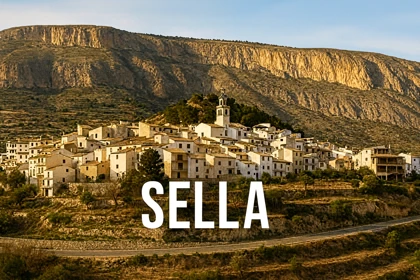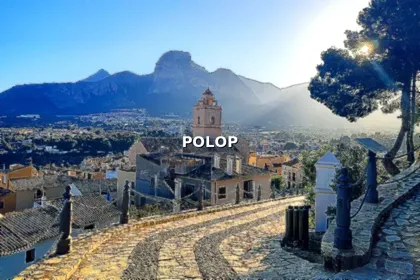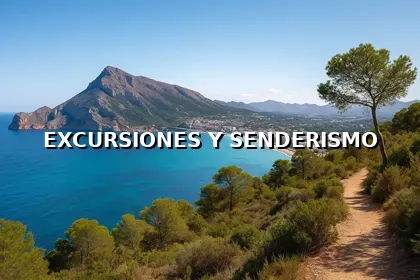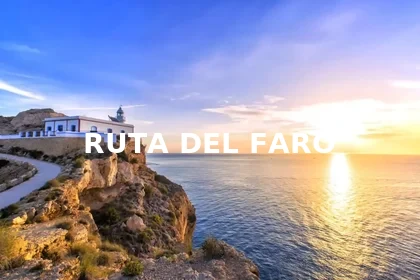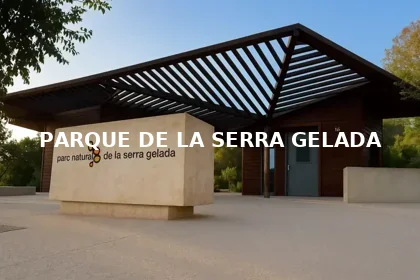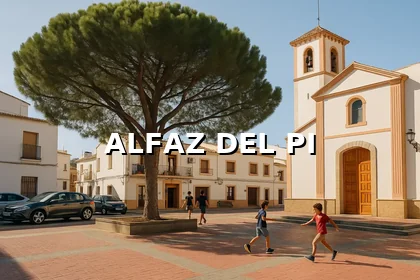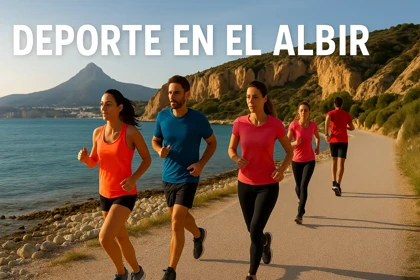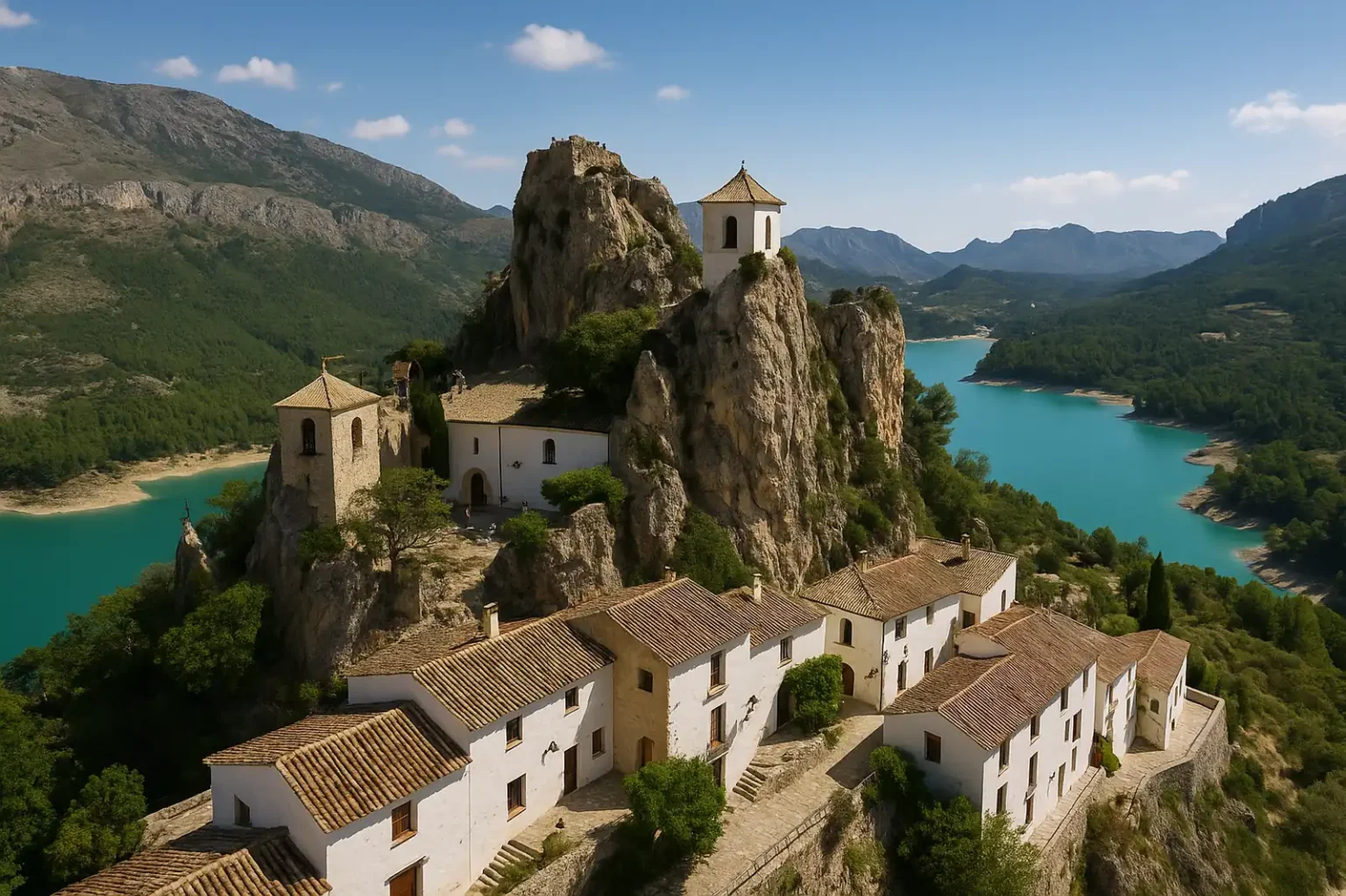
Updated: September 2025 • Reading time: 7–9 min
Guadalest is one of the most visited towns in Alicante in 2025. In this guide, you’ll find everything you need for your visit: how to get there, what to see in a day, castle opening hours and prices, available parking, the best viewpoints of the reservoir, where to eat, where to stay, and nearby excursions.
Table of Contents
ToggleQUICK PLAN IN 1 DAY
The essential route to see Guadalest without wasting time. Includes the castle, viewpoints, a reservoir, and a good place to eat.
Morning (10:00): Enter through the rock tunnel and climb to San José Castle and Casa Orduña (prices and times may vary on holidays; confirm on the official website or Tourist Info).
Midday (1:30 p.m.): homemade menu at El Riu or El Tossal (€15–20 approx.).
Afternoon (3:30 PM): Choose a museum: Microminiatures, Torture, or Ethnology. Then, head down to the reservoir for a short walk.
Sunset (7:00 p.m. summer / 5:30 p.m. winter): final photo at the Mirador del Castillo with the turquoise of the swamp in the background.
HOW TO GET TO GUADALEST: ROUTES AND TRANSPORT
Guadalest is located inland in the province of Alicante, just a few kilometers from the coast. Access is easy and well signposted, both by car and public transport.
By car
From Benidorm → 35 min via the CV-70.
From Altea or El Albir → 40 min, with winding stretches and spectacular scenery.
From Alicante → 1 h 10 min via the AP-7 and CV-70.
From Valencia → Approx. 2 hours, ideal weekend trip.
By bus
Line 16 connects Benidorm with Guadalest. It departs in the morning and returns in the early afternoon (limited service) .
Organized excursions
Several agencies in Benidorm and Altea offer combined excursions to Guadalest + Fuentes del Algar , with transportation included.
Parking
Guadalest has three parking areas at the entrance to the village. Price: ~€2 per day. From there, the historic center is a 5-minute walk away.
Tip: In summer, arrive before 11:00 a.m. to avoid queues and secure your spot.
WHAT TO SEE IN GUADALEST IN 2025: ESSENTIALS.
Guadalest can be explored in just a few hours, but every corner has a story to tell. These are the places you can’t miss:
San José Castle
The town’s emblem. Accessed through a tunnel dug into the rock, at the top you’ll be treated to panoramic views of the Guadalest reservoir and the Aitana mountain range, which will remain etched in your memory forever.
Entrance fee : €4–5 (includes the Orduña House).
Opening hours : Summer 10:00–20:00 / Winter 10:00–18:00.
Orduña House
Former residence of a noble family, rebuilt after the 1644 earthquake. Today it serves as a museum with furnishings, historical artifacts, and works of art depicting the life of the local elite.
Museums of Guadalest
The town boasts more museums than bars. Highlights include:
Microminiatures Museum : where you can see a Naked Maja painted on a grain of rice.
Torture Museum : instruments that tell the dark side of history.
Ethnological Museum : dedicated to rural life and the traditions of the Alicante mountains.
Historic Vehicle Museum : Located just outside the city, with more than 140 vintage motorcycles and cars.
Church of the Virgin of the Assumption
Built in the 18th century, it stands out for its Baroque style and its importance as a meeting point for the local community.
Viewpoints and squares
Every corner of the old town is a lookout point: balconies with wrought-iron railings, plazas opening onto the valley, cobblestone streets lined with bougainvillea. The most sought-after is the Mirador del Castillo , perfect for photos with the reservoir in the background.
GUADALEST RESERVOIR: THE TURQUOISE LAKE AMONG MOUNTAINS.
At the foot of the castle lies one of the most striking landscapes in the Marina Baixa: the Guadalest Reservoir (also known as the Guadalest Marsh ). Its emerald waters contrast with the mountains of the Sierra de Aitana and the Serrella , creating a picture that looks like something out of a postcard.
This reservoir was built in the mid-20th century to regulate water in the region and has since become a tourist attraction in its own right.
What to do at the Guadalest reservoir
Walk around the reservoir : easy trails that allow you to surround part of the reservoir and enjoy nature.
Photography : The castle’s viewing platforms are the best place to capture the complete panorama.
Bike and trail running routes : perfect for those looking for mountain sports.
Kayaking and water activities (seasonal): Some operators offer leisurely trips on the lake.
Best views of the reservoir
From the San José Castle Viewpoint .
From the CV-70 highway before reaching the town.
From the path that connects to the nearby town of Beniardà .
Easy mini-routes from the reservoir
Although many visitors are content with just a photo from above, it’s worth going down and spending some time exploring one of the easy trails that surround the reservoir. These routes aren’t included in most basic guidebooks and are ideal for those seeking direct contact with nature without much effort.
Dam Walk
Duration: 30–40 min round trip
The paved and safe path is perfect for families and seniors. You walk along the dike that holds back the water, with picture-postcard views of the castle above.North shore trail
Duration: 45–60 min
An easy walk with shaded sections and small, impromptu picnic areas. As you walk along, the water’s color intensifies and the panoramic views become more expansive.Connection with Beniardà
Duration: 1 hour 15 minutes
A slightly longer but easy path connects the reservoir with the neighboring village. Halfway along, there are natural viewpoints that are not usually included in tourist routes.
Practical tip: Wear comfortable shoes, bring water and a hat in summer. Avoid the middle of the day between July and August, as there is very little shade in some sections.
PHOTOS OF GUADALEST: THE BEST VIEWPOINTS AND CORNERS
Guadalest is a paradise for photographers and Instagram lovers. Its medieval streets and mountain landscapes make every corner picture-postcard-worthy. Here are the most photogenic spots:
Castle Viewpoint
A classic must-see. From the top of San José Castle, you can get the best photos of the turquoise reservoir with the Sierra de Aitana and Serrella mountains in the background.
Cobbled entrance to the old town
The walk up the main street, lined with stone houses and flowering bougainvillea, creates a medieval atmosphere perfect for portraits and atmospheric photos.
Balconies of the Microminiatures Museum
In addition to its unique collections, this museum offers panoramic balconies with spectacular views.
At dusk
The most magical moment for photography: the village’s stonework takes on golden hues while the sky is reflected in the water of the reservoir.
Tips for photographers
Use polarizing filters to enhance the contrast between water and sky.
It has a wide-angle lens to capture narrow streets and wide viewpoints.
If you’re looking for something unique, visit the reservoir at dawn: fewer people and the light is soft.
WHAT TO DO IN GUADALEST IN ONE DAY: RECOMMENDED ITINERARY
Although the town is small, it’s worth spending a full day there to savor every corner at your leisure. Here’s an itinerary designed to make the most of your visit:
Tomorrow
Walk through the old town, entering through the tunnel carved into the rock.
San José Castle : Go up early to avoid crowds and enjoy the views of the reservoir.
Casa Orduña : Take advantage of the fact that it is included in the castle entrance fee and learn how a noble family lived.
Noon
Food in Guadalest : Try a traditional menu at restaurants like El Riu or El Tossal . Typical dishes like minxos (stuffed empanadas), olleta de blat (wheat stew), and homemade sausages are always a hit.
Late
Thematic museums : depending on your interests, you can choose between Microminiatures, Torture, or Ethnological.
Route to the reservoir : walk down to the dam or take a short walk along the trails that border the lake.
Sunset Lookout : Return to the castle or main square to watch the sun turn the mountains golden.
Optional
If you have the time and the car, combine the day with a visit to the Algar Springs , just 15 minutes away, a perfect complement to a well-rounded day.
Restaurants in Guadalesti: Where to Eat Well and Cheaply
A visit to Guadalest wouldn’t be complete without trying its mountain cuisine, simple yet full of flavor. Here are options for all budgets:
Typical dishes you must try
Minxos → vegetable or fish empanadas, a humble and very popular recipe.
Olleta de blat → hearty stew with wheat, vegetables and sausage.
Artisan sausages → chorizos, longanizas and blood sausages made in the area.
Local wines → Nearby wineries produce Mediterranean-style wines.
Recommended restaurants in Guadalest
The Riu → one of the most popular, abundant menu with homemade dishes.
El Tossal → restaurant-hotel with local cuisine and panoramic terrace.
El Patio → a good option for eating with views of the valley.
Cheap eats in Guadalest
Although it’s a tourist destination, there are daily menus between €15 and €20 . Many include a starter, main course, dessert, and a drink. Ideal if you’re looking for a good meal without spending too much.
Eat like a local: Authentic bars and taverns
Beyond the tourist restaurants in the old town, the villages of the valley offer bars and taverns where locals have always eaten. These are simple places, with home-style meals and lower prices than in the center of Guadalest.
Bar Nou (Benimantell)
Set menu between €12–14, with traditional dishes such as olleta de blat (a type of stew) , meat stews, and homemade desserts. Family atmosphere and local clientele.Mesón Ca Rafel (Callosa d’en Sarrià)
Traditional stews and grilled dishes. On weekends they prepare baked rice and flatbreads . A place where tourists rarely venture.Baret de Beniardà
A small bar in the village square, serving simple tapas and local wines. Ideal to combine with a walk to the reservoir along the connecting path.
Restaurants near Guadalest
In neighboring towns like Benimantell and Callosa d’en Sarrià, you’ll find traditional bars and taverns that are less touristy and offer more reasonable prices.
Hotels and accommodations in Guadalest: sleep with charm
Although many visitors come to Guadalest for a half-day trip, more and more travelers choose to spend the night and enjoy the silence and magic of the town once the tourists have left.
Hotels in Guadalest
Cases Noves → A small boutique hotel with valley views, highly rated for its friendly atmosphere and homemade breakfasts.
El Tossal → rural hotel with its own restaurant, comfortable rooms and a panoramic terrace.
Rural houses and apartments
Perfect for families or groups seeking more independence: renovated stone houses with fireplaces and terraces overlooking the reservoir.
Unique accommodations
Bubble glamping in Guadalest → Sleep under a starry sky in the mountains, with transparent domes.
Apartments with views → some with balconies overlooking the reservoir, ideal for romantic getaways.
Hotels near Guadalest
If you prefer to sleep in nearby towns:
Benimantell → Authentic rural options and good gastronomy.
Callosa d’en Sarrià → more offers and slightly lower prices.
WEATHER IN GUADALEST: CLIMATE AND BEST TIME TO VISIT
Guadalest, being in the mountains but close to the sea, has a mild Mediterranean climate , with hot, dry summers and mild winters.
Spring (March – June)
The best time: mild temperatures, fields in bloom, and the reservoir a deep blue. Ideal for hiking and photography.
Summer (July – September)
More heat and more tourism. Temperatures can exceed 30°C, but the town offers shady cobblestone streets and cool terraces. Perfect for combining with a dip in the Algar Springs .
Autumn (October – November)
The golden light at sunset transforms the Old Town into a fairytale setting. Plus, there are fewer tourists and lower prices.
Winter (December – February)
A peaceful and authentic atmosphere. It rarely freezes, and temperatures typically range between 10 and 15°C during the day.
FESTIVALS AND TRADITIONS OF GUADALEST 2025
Despite its size, Guadalest maintains a vibrant festival calendar that reflects the traditions of the Alicante mountains. If you happen to visit during one of these celebrations, your visit will be extra special.
Patron Saint Festivities (August)
In honor of the Virgin of the Assumption , the town’s patron saint, solemn processions, live music, fireworks, and communal meals are held, bringing together locals and visitors.
Craft Fair (Easter and Summer)
The streets are filled with stalls selling local products, traditional crafts, and open-air workshops. It’s an ideal opportunity to buy authentic souvenirs such as pottery, textiles, or homemade sausages.
Cultural Week (autumn)
Lectures, theater, and exhibitions highlighting the history and culture of Guadalest and its valley. A quieter atmosphere closely linked to local life.
WHAT TO SEE NEAR GUADALEST: VILLAGES AND EXCURSIONS
Guadalest is small, but its surrounding area is full of charming villages and mountain landscapes that are worth a stop. Here are some ideas:
Nearby towns
Beniardà → a quiet place next to the reservoir, ideal for walking and relaxing.
Benimantell → famous for its good gastronomy and the baroque church of San Vicente Mártir.
Confrides → the most mountainous, with remains of an Arab castle and spectacular panoramic views.
Nearby nature
Fuentes del Algar → just a 15-minute drive away, waterfalls and natural pools where you can cool off in the summer.
Sierra de Aitana → hiking trails with views of the entire Marina Baixa.
Serra de la Xortà → perfect for lovers of the most adventurous trekking.
Combined excursions
Many travelers organize a full day with Guadalest + Fuentes del Algar , or even an Altea – Callosa – Guadalest circuit.
PRACTICAL TIPS FOR VISITING GUADALEST
Visiting Guadalest is easy, but these details will help you get the most out of your experience:
Guadalest with children
The old town is pedestrianized, so it is comfortable and safe.
The Microminiatures Museum is usually a favorite with the little ones.
Be careful with baby strollers: there are steep slopes and cobblestone stairs.
Best time for photos
Tomorrow : clear light over the reservoir.
Sunset : golden tones on the castle stone and reflections in the water.
Indicative prices
Entrance to the Castle + Orduña House : €4–5.
Thematic museums : between €3 and €5 each.
Restaurant menu : €15–20.
Rural hotel accommodation : from €80–100 per night in mid-season.
Recommended visit time
The ideal option is to spend half a day or a full day exploring the historic center, visiting a couple of museums, eating in the town, and taking a walk along the reservoir.
Safety and accessibility in Guadalest
Although Guadalest is a small and quiet village, there are certain details that are worth knowing to enjoy your visit without any surprises:
Cobblestone streets and hills
The old town has slopes and uneven paving. Wear comfortable shoes with good grip, especially if it’s raining.Access with stroller
Not all areas are suitable for strollers. The entrance through the rock tunnel is the easiest. If you’re traveling with babies, it’s best to bring a baby carrier.Elderly people or people with reduced mobility
The lower part of the village is accessible and has benches for resting. Reaching the castle requires climbing stairs, so be prepared for the effort.Summer and high temperatures
There is little shade during the middle of the day. Bring water, a hat, and sunscreen. It’s best to visit in the morning or at sunset.General security
The town is very safe, but on busy days (August, Easter) keep an eye on bags and backpacks in narrow passage areas.
The history of Guadalest: from an Arab fortress to a tourist icon
The history of Guadalest begins in the Muslim era , around the 11th century, when the Arabs built a fortress atop a rocky spur. Its strategic position allowed them to control access to the valley and monitor the routes to the coast and the mountains. For centuries, the castle witnessed battles, alliances, and sieges.
With the Christian conquest in the 13th century , the fortress became part of the Crown of Aragon . In subsequent centuries, various noble families took over its administration. Among them, the Orduña family stands out, leaving their mark with the construction of the Orduña House, now a museum.
The history of Guadalest has not been without tragedy. The 1644 earthquake destroyed part of the castle and the town center, and the 17th and 18th centuries saw conflicts and crises that marked its architecture and population. Even so, the town remained standing, preserving its medieval layout, with walls, entrance gates, and cobblestone houses that can still be explored today.
In the 20th century, with the creation of the Guadalest reservoir , the valley’s landscape changed forever, giving the town an even more spectacular image: the turquoise blue of the water at the foot of the mountain.
Today, Guadalest is considered a Historic-Artistic Site and a symbol of resistance and cultural coexistence in the Valencian Community. Every corner of the town recalls its past, from the watchtower to the museums that preserve traditions and artifacts from bygone eras.
QUICK QUESTIONS ABOUT GUADALEST
How much does it cost and what time do the Orduña Castle and House open?
Combined admission: €4 for adults; regular opening hours: 10:00 AM to 7:00 PM , closed from 2:00 PM to 3:00 PM (Thursdays and Sundays). See the Quick Day Plan section.
How to get there and how much does parking cost?
By car: 35 min from Benidorm , 1 h 10 min from Alicante . Bus line 16 from Benidorm (round trip for about €7.50). Parking near the village: ~€2/day .
What to see if you only have half a day?
Castle, Casa Orduña, a surprising museum, and a view of the reservoir from the Mirador del Castillo. Check out our Quick Plan for 1 Day .
What is the best time for photos?
In the morning with clear light and at sunset, when the stone takes on warm, golden tones. Perfect for Instagram.
(Based on photographic observation from Tips for Photographers )
What nearby excursion is worth adding?
The Algar Springs , just a 15-minute drive away, are a perfect alternative for a full day.
Official sources and links about Guadalest
To prepare this guide, we have consulted official and verified sources that you can use as a reference if you would like more information:
RELATED TOPICS THAT MAY ALSO INTEREST YOU
If you visit Guadalest, you’ll also enjoy discovering other nearby spots and experiences on the Costa Blanca:
